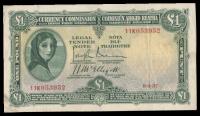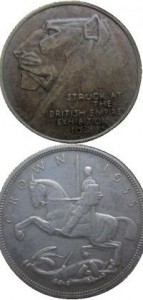A single currency for the British Empire? A warning for the Euro
Published in 18th–19th - Century History, Features, General, Issue 1(Jan/Feb 2013), Volume 21
An Irish Free State ‘one pound sterling payable to bearer on demand in London’. What was the position of the infant Irish Free State with respect to the proposed imperial currency?
Examples of monetary union include those between the city states of ancient Greece, the attempts to coordinate the currencies of nineteenth-century German states and the Latin Monetary Union that existed in continental Europe between 1866 and 1927. The United Kingdom, at that time including Ireland, decided to remain aloof from the Latin Monetary Union. The British maintained this policy a century later with respect to the Euro.

Percy Metcalfe, who designed the first Irish coins, influenced coinage throughout the British Empire.
Economic links with the ‘mother country’ were stronger in Australia, New Zealand and South Africa. These dominions had their own pound currencies, linked to the value of gold at the same level as the pound sterling. The link between these countries and the pound sterling was threatened by the outbreak of the First World War in 1914. The economic strains caused by the conflict forced the United Kingdom to break the link between the pound sterling and the value of gold. Soon the value of the British pound sterling began to fluctuate with respect to the Australian, New Zealand and South African pounds, with predicable inconvenience to imperial trade. This led to calls for a single currency in order to bring the economies of the global empire closer together.
The proposal for a single British Empire currency was made in London at the imperial conference of 1923. This was one of the first international gatherings attended by the fledging Irish Free State. The 1921 Anglo-Irish Treaty had given the Free State the same status as the self-governing dominions of Canada, Australia, New Zealand, South Africa and Newfoundland. Irish attendance at this imperial conference reflected this reality.
Single imperial currency proposed by New Zealand

He first came to prominence for his medals struck for the British Empire Exhibition of 1924 (top). One of his most famous creations was the ‘rocking horse’ crown (five shillings) to celebrate George V’s silver jubilee in 1933
The proposal for a single imperial currency was the brainchild of the British economist J.F. Darling. His proposal was brought to the table of the imperial conference by the New Zealand delegation, who were supported by their Australian neighbours. The proposed currency union expressly excluded India, the jewel in the imperial crown. The weak Indian rupee, based on the value of silver, was essential for ensuring its continued economic subservience within the empire.

Coinage throughout the empire bore a portrait or the initials of the ruling monarch as the source of imperial unity. George V appears with a crown on this 1935 Australian penny (left) in accordance with colonial practice. He appears bareheaded on this 1935 United Kingdom five-shilling piece (right) in accordance with British practice. The 1928 Irish penny (middle) shatters this aspect of imperial unity.
Sustained criticism from the centre of the empire ensured that the new imperial currency never got off the ground. The response of one of the participants at the 1923 imperial conference has not yet been examined, however. What was the position of the infant Irish Free State with respect to the proposed imperial currency? The surprising answer is one of apparent indifference. The government did not send a representative from the Department of Finance to the relevant discussions at the imperial conference. The Irish delegate who did attend, E.J. Riordan of the Department of Industry and Commerce, admitted to not being able to ‘contribute anything of value to the discussion’.
















